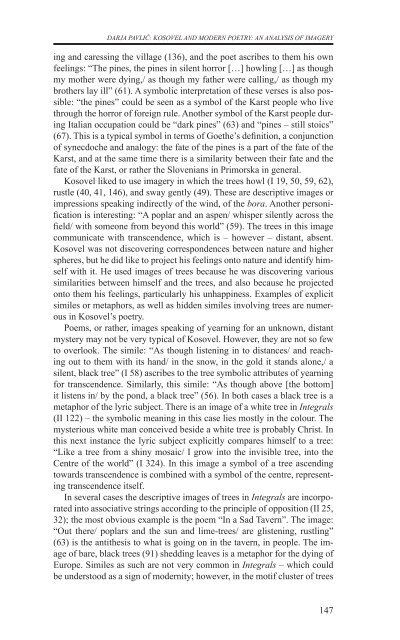razprave (pdf) - Društvo za primerjalno književnost - ZRC SAZU
razprave (pdf) - Društvo za primerjalno književnost - ZRC SAZU
razprave (pdf) - Društvo za primerjalno književnost - ZRC SAZU
- No tags were found...
Create successful ePaper yourself
Turn your PDF publications into a flip-book with our unique Google optimized e-Paper software.
Darja pavlič: KOSOVEL AND MODERN POETRY: AN ANALYSIS OF IMAGERYing and caressing the village (136), and the poet ascribes to them his ownfeelings: “The pines, the pines in silent horror […] howling […] as thoughmy mother were dying,/ as though my father were calling,/ as though mybrothers lay ill” (61). A symbolic interpretation of these verses is also possible:“the pines” could be seen as a symbol of the Karst people who livethrough the horror of foreign rule. Another symbol of the Karst people duringItalian occupation could be “dark pines” (63) and “pines – still stoics”(67). This is a typical symbol in terms of Goethe’s definition, a conjunctionof synecdoche and analogy: the fate of the pines is a part of the fate of theKarst, and at the same time there is a similarity between their fate and thefate of the Karst, or rather the Slovenians in Primorska in general.Kosovel liked to use imagery in which the trees howl (I 19, 50, 59, 62),rustle (40, 41, 146), and sway gently (49). These are descriptive images orimpressions speaking indirectly of the wind, of the bora. Another personificationis interesting: “A poplar and an aspen/ whisper silently across thefield/ with someone from beyond this world” (59). The trees in this imagecommunicate with transcendence, which is – however – distant, absent.Kosovel was not discovering correspondences between nature and higherspheres, but he did like to project his feelings onto nature and identify himselfwith it. He used images of trees because he was discovering varioussimilarities between himself and the trees, and also because he projectedonto them his feelings, particularly his unhappiness. Examples of explicitsimiles or metaphors, as well as hidden similes involving trees are numerousin Kosovel’s poetry.Poems, or rather, images speaking of yearning for an unknown, distantmystery may not be very typical of Kosovel. However, they are not so fewto overlook. The simile: “As though listening in to distances/ and reachingout to them with its hand/ in the snow, in the gold it stands alone,/ asilent, black tree” (I 58) ascribes to the tree symbolic attributes of yearningfor transcendence. Similarly, this simile: “As though above [the bottom]it listens in/ by the pond, a black tree” (56). In both cases a black tree is ametaphor of the lyric subject. There is an image of a white tree in Integrals(II 122) – the symbolic meaning in this case lies mostly in the colour. Themysterious white man conceived beside a white tree is probably Christ. Inthis next instance the lyric subject explicitly compares himself to a tree:“Like a tree from a shiny mosaic/ I grow into the invisible tree, into theCentre of the world” (I 324). In this image a symbol of a tree ascendingtowards transcendence is combined with a symbol of the centre, representingtranscendence itself.In several cases the descriptive images of trees in Integrals are incorporatedinto associative strings according to the principle of opposition (II 25,32); the most obvious example is the poem “In a Sad Tavern”. The image:“Out there/ poplars and the sun and lime-trees/ are glistening, rustling”(63) is the antithesis to what is going on in the tavern, in people. The imageof bare, black trees (91) shedding leaves is a metaphor for the dying ofEurope. Similes as such are not very common in Integrals – which couldbe understood as a sign of modernity; however, in the motif cluster of trees147
















